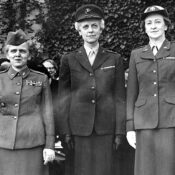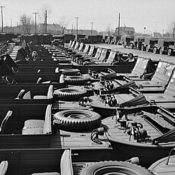 Seventy-five years ago today, America launched the first of its World War II military operations that would ultimately lead to victory three years later.
Seventy-five years ago today, America launched the first of its World War II military operations that would ultimately lead to victory three years later.
After the attack at Pearl Harbor in 1941, America was in desperate need of heroes. Four months had passed since our Navy had been caught by the surprise attack, and the U.S. had yet to strike back at Japan. It would be months before our G.I.s would confront either Japanese or German troops and take the initiative in the war.
Fortunately, a hero emerged in April 1942, when Americans learned that the U.S. had struck a blow against the Japanese empire in downtown Tokyo. The hero was the man who’d led the mission: General Jimmy Doolittle.
President Roosevelt had been calling for some military action to boost the country’s morale and show America’s determination not to let the Pearl Harbor attack go unanswered. A successful retaliation, he reasoned, would also erode Japanese confidence in their government. The U.S. developed a plan to bomb Tokyo with 16 modified B-25 bombers launched from an aircraft carrier. It was a risky mission: none of the pilots had ever taken off from an aircraft carrier before, and there was no telling what sort of air defense the crews would face when entering Japan.
This news reel from 1942 shows footage of preparations for and aftermath of the Doolittle Raid. Castle Films. From the Pare Lorentz Center at the Franklin D. Roosevelt Presidential Library and Museum.
Now the element of surprise was gone. Doolittle’s fliers were still 170 miles from their launch point. It would take another 10 more hours before they could reach a point from which the planes could fly to Tokyo and return — 10 hours that would give the Japanese plenty of time to launch their fighter defenses.
Doolittle decided to start the mission. His crews would hit the target and, instead of vainly trying to return to the carrier, would keep flying west to China. There, they would try to find friendly air fields, or crash land, or simply have their crews bail out.
The 16 U.S. bombers entered Japanese air space around noon and dropped bombs on Tokyo and five other cities.
With Japan behind them, the crews were still not out of danger. One bomber, short of fuel, landed in Soviet Russia, and its crew was imprisoned. Two went down in the sea and were picked up by the Japanese. The crews were held as prisoners, and three officers were executed by the Japanese for “war crimes.”
Doolittle and the rest of the crews made it to China, where they were helped by civilians and soldiers back to Allied forces.
The damage of the Doolittle raid was, in military terms, light, though they destroyed oil tanks, a steel mill, power plants, and an aircraft carrier under construction.
Yet the mission was a success in two regards. Americans’ pride in their armed forces was restored, and Japanese faith in their military took a hit. Like the Germans, the Japanese had been assured by their leaders that they would never be bombed. And now the Americans were striking the homeland in broad daylight.
There was a third outcome that had broad consequences. Eager to prevent any more air attacks, the Japanese military decided to capture the Midway Atoll to prevent it from becoming an air base for U.S. bombers. This led to the pivotal battle of Midway, a decisive, hard-won victory for America.
“Rough-On-Japs Doolittle” by Lewis B. Funke presents Jimmy Doolittle as the hero America needed. What emerges from the story is a man who embodies all the qualities we want in heroes: modesty, fearlessness, intelligence, and a sense of humor.

Become a Saturday Evening Post member and enjoy unlimited access. Subscribe now




Comments
So this was four months after Doris Miller became the actual first hero of WW2?